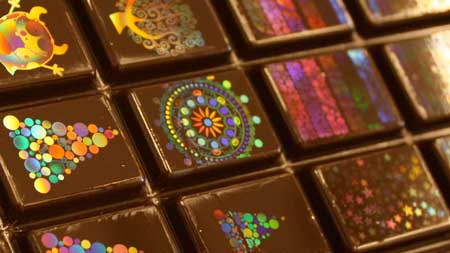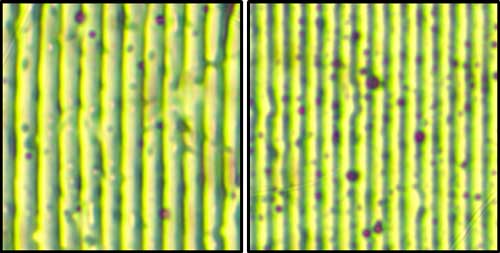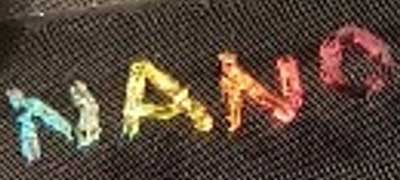| Feb 17, 2021 | |
Printing edible nanostructured holograms on food |
|
| (Nanowerk Spotlight) Holograms are widely used for security applications in bank notes, credit cards and safety seals on packaging (even wine makers have begun adding holographic labels to their bottles) because they are complex optical devices that are difficult to make and therefore reduce the chances of counterfeiting. | |
| Other areas where holograms are increasingly being used is by the military in form of flexible holographic maps; holographic data storage (unlike CDs and DVDs, which store their data on the disc's surface, holograms store data in three dimensions and those pages can overlap in the storage space) – even holographic atomic memory that works with single photons; and of course art – artists became involved with holography almost as soon as it became a practical optical process. | |
| Food might be the next area that could see widespread use of holograms. Chocolatiers already have demonstrated holographic color effects on chocolate that are created directly from the injection-moulded or thermo-formed chocolate plastic moulds. They give the chocolate surface a specific controlled roughness that diffracts the light and makes it shiny. | |
 |
|
| Holographic chocolate surfaces. (Image: Morphotonix) | |
| "But beyond aesthetics, holograms on food—specifically, edible holograms—could be used to reduce packaging needs, for example, as information about nutritional content or labels could be printed directly onto the food item," Dr. Haider Butt, an associate professor in the Department of Mechanical Engineering at Khalifa University, tells Nanowerk. "To that end, we developed a quick and low-cost fabrication method for producing holograms on corn syrup films." | |
| The researchers published their findings in ACS Nano ("Direct Printing of Nanostructured Holograms on Consumable Substrates"). | |
| Butt and his team used holographic direct laser interference pattering (DLIP) – a direct, simple, low cost and rapid technique that requires only one processing step and doesn't require masks or templates. They developed a DLIP method to directly pattern one-dimensional nanostructures on edible substrates (dried films of corn syrup). | |
 |
|
| Periodic gratings produced at two different tilt angles on corn syrup thin films observed under an optical microscope. (Image: Dr. Haider Butt, Khalifa University) | |
| The holographic pattern created by this method depends on the number of interfering beams and their incident angles, polarization, and intensity. The team notes that hologram surfaces diffracted a wide range of visible wavelengths depending on the tilt angle of the hologram with respect to the incident light. | |
| The researchers deposited a thin layer of synthetic black dye (900 nm thickness) onto the corn syrup thin film in order to maximize the laser pulse absorption. This enabled the ablation process (which removes a significant portion of the black dye) to generate low-cost nanostructures on the surface of the corn syrup film. | |
| "Currently our work is limited because of the usage of commercial synthetic black dye," says Butt. "In the future, we will use food-grade dyes and optimize the pulsed laser's parameters accordingly for producing edible holograms." | |
 |
|
| Holographic image of the word 'NANO' on corn syrup film displaying rainbow colors. (Image: Dr. Haider Butt, Khalifa University) | |
| These edible holograms could find applications in the areas of food safety, for instance as sensors for harmful bacteria or to monitor food quality and shelf life. Since the holograms can be used to print for instance nutritional information directly onto food items, it could also reduce the need for packaging materials. | |
| The researchers point out that a thorough future study is needed to quantify the shelf life of these holograms in different storage conditions. They also need to investigate the effects of temperature and moisture on the corn syrup. | |
 By
Michael
Berger
– Michael is author of three books by the Royal Society of Chemistry:
Nano-Society: Pushing the Boundaries of Technology,
Nanotechnology: The Future is Tiny, and
Nanoengineering: The Skills and Tools Making Technology Invisible
Copyright ©
Nanowerk LLC
By
Michael
Berger
– Michael is author of three books by the Royal Society of Chemistry:
Nano-Society: Pushing the Boundaries of Technology,
Nanotechnology: The Future is Tiny, and
Nanoengineering: The Skills and Tools Making Technology Invisible
Copyright ©
Nanowerk LLC
|
|
|
Become a Spotlight guest author! Join our large and growing group of guest contributors. Have you just published a scientific paper or have other exciting developments to share with the nanotechnology community? Here is how to publish on nanowerk.com. |
|
